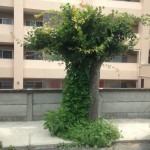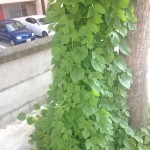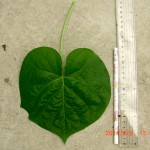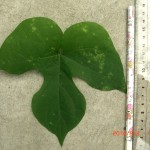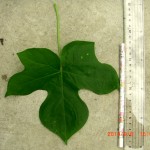Original Japanese written by staffer
The English below translated from the original Japanese by Heeday
The English translation edited by Rev. Dr. Henry French, ELCA
In the parking area next to our Project’s office, a maple tree and a morning glory grow. Ever since the Fukushima Daiichi Nuclear Power Plant began melting down, both have been showing abnormalities. After the disaster began, the maple was trimmed to the bare trunk, as part of the decontamination work.
The morning glory was sown two years ago, and has been left unattended since. Still, every early summer it shoots out buds. It is overgrown with many leaves of different sizes and shapes, but it has borne almost no flowers in the last two years.
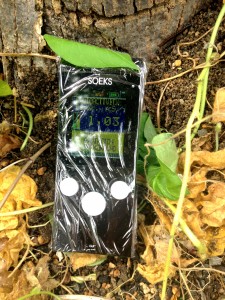 The soil around the maple’s root has not been “decontaminated.” We measured the radioactivity there and found 1.03mSv/h, on August 12th, 2015.
The soil around the maple’s root has not been “decontaminated.” We measured the radioactivity there and found 1.03mSv/h, on August 12th, 2015.
On the same day, we took a leaf from both the morning glory and the maple, and took them for radioactivity measurement at the Health Control Section, Koriyama Public Health Center. The documents shown right describe their measurements.
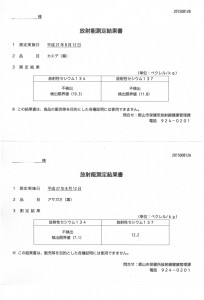 The person who took the measurements gave the following explanation:
The person who took the measurements gave the following explanation:
“The radioactive isotopes, Cs134 and Cs137, are both artificial and do not exist naturally. Cs134 has a half-life of around 2 years, and Cs137 some 30 years.
In case Cs134 is detected, it is mostly ascribable to the Fukushima meltdown, not the Chernobyl disaster or any nuclear tests, since this isotope’s half-life is very short. Also, due to their half-lives, the two isotopes, 134 and 137, exist at the ratio of 3 to 10. In the morning glory leaf, we measured 12.2 Becquerel per kg of Cs137. Applying the existence ratio to this measurement, it should contain around 4 Becquerel of Cs134 per kg. This is below the minimum quantity detectable, so our equipment was unable to detect 134.
Since the morning glory and maple leaves measured this time were not cleansed after they were taken off, it is uncertain whether the radioactivity measured is from some substance on the leaf or from some soil mixed in.
Also, an air dosimeter, when placed close to a subject of measurement, does not respond unless its radioactivity is 8,000 Becquerel or above. So, with this morning glory leaf’s radiation dose, an air dosimeter will not respond.”
Now, last summer, we witnessed similar abnormalities with the plants.
▲Some gigantic leaves of different shapes from the same morning glory. They are around 16cm (6.3”) in full length. (Photographed on September 8th, 2014)
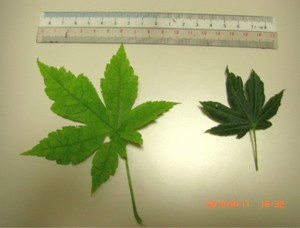 [Right] A regular-sized maple leaf
[Right] A regular-sized maple leaf
[Left] A leaf from the maple that has grown into a giant
(Photographed on August 11th, 2014)
Here in Fukushima, every day TV and radio news programs and newspapers report air radiation doses at many different places in the Prefecture. They also report monitoring of radioactivity in the sea water near the Fukushima Daiichi Nuclear Power Plant.
Sea water monitoring results often say “ND” (Not Detected) with respect to Cs134 and 137. Such a report does NOT mean the sea water inspected was found to contain no radioactivity. It actually means that the radioactivity was below the minimum measurable limit of the measuring instrument used. Thus, a ND report does not guarantee “safety.” Please be careful.
Also, the municipal government of Koriyama City reported, in July 2015, that the average air dose of radiation across the city was 0.10 to 0.20mSv/h. Still, when our Project’s staffers tried measuring doses with a Geiger counter, they found some places exceeding 1mSv/h. Thus, too much trust in publicly announced air doses can be dangerous.
Different people have different notions about radioactivity, which is invisible. If one is exposed to “take-it-easy” reports day in and day out, they can be tempted to ignore unusual things that they find in their environment. However, such small, unusual things might be signs of some greater issues.
Thus, we, the Project, intend to examine and publish in this website little abnormalities that we notice in our everyday life, without discounting them as “simply subjective,” in the years to come.

